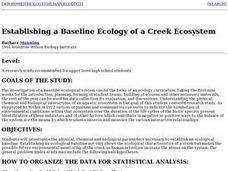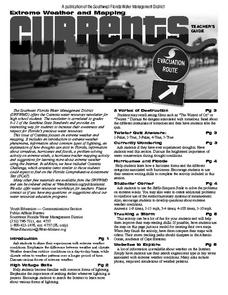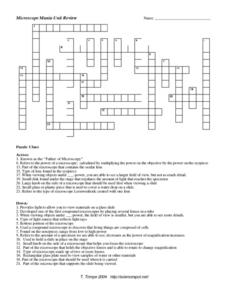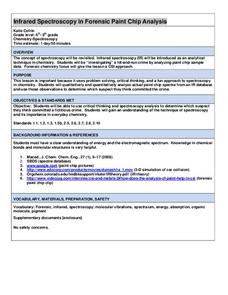Curated OER
The Delicate Balance within a Forest Ecosystem
Students examine the causes and effects of alterations in a forest ecosystem and evaluate how human actions may only seem to have minor consequences, but can lead to extinctions of large numbers of populations. Students produce an...
Curated OER
Establishing a Baseline Ecology of a Creek Ecosystem
Students investigate the physical, chemical and biological parameters necessary to establish an ecological baseline. Establishing an ecological baseline not only shows the ecological characteristics of a creek but makes the possible...
Curated OER
Extreme Weather and Mapping
In this environment worksheet, students read an article about extreme weather conditions and mapping it out. They respond to 10 multiple choice questions about what they read. Then, students explain how droughts can occur and the...
Curated OER
Water Web
In this water web worksheet, students explore, analyze and discuss how weather stations interact with maintaining weather conditions and answer two essay questions and ten multiple choice questions.
Curated OER
Microscope Mania Unit Review
In this microscope worksheet, students complete a crossword puzzle given twenty three hints about the parts of a microscope, the magnification of a microscope and the types of microscopes.
Curated OER
National Estuarine Research Reserve System
Young scholars investigate the benefits of estuarine research reserves. In this National Estuarine Research Reserve lesson plan, students learn how to obtain information on the 26 reserve sites, they discuss the importance of the reserve...
Curated OER
Exploring Explorations-Ocean Exploration
Students learn about Earth's deep ocean discoveries and their benefits. In this ocean exploration lesson, students review previous explorations of the Earth's deep oceans and learn about the discoveries of the past.
Curated OER
What on Earth is That and How Can I Get One?
Students examine how we use submersibles. In this technology based lesson, students examine various technologies used by submersibles in ocean exploration.
Curated OER
Energy Changes, Rates of Reactions, Nuclear Chemistry
In this energy changes, rates of reactions and nuclear chemistry learning exercise, students solve 14 problems to review concepts about endothermic and exothermic reactions, heat of combustion, heat of reactions, enthalpy, kinetic and...
Curated OER
The Weather Page: Comparing Data
Students recognize the different types of data on the weather page of USA Today. In this weather lesson, students compare weather data comparative and superlative forms of adjectives. Students locate 10 pieces of information in the data...
Curated OER
Reduce Reuse Recycle
Students discover methods that can save the planet by recycling. For this sustainable planet lesson, students read The Berenstein Bears Don't Pollute Anymore, and practice memorizing the 3 R's. Students write commitment letters...
Curated OER
Candy Chemosynthesis
Students explain chemosynthesis and photosynthesis using candy. In this chemosynthesis lesson plan, students work cooperatively to create a visual explanation of the chemical equations of photosynthesis and chemosynthesis.
Curated OER
Bad Algae!
Students explore algal blooms. In this ecosystem and health lesson, students define and describe harmful algal blooms, then discuss ways in which the impact of these algal blooms could be reduced. Students work in groups to research...
Curated OER
Infrared Spectroscopy in Forensic Chip Analysis
Students analyze spectrums as related to forensics. In this chemistry lesson, students define spectroscopy and discuss its use in chemistry. They discuss how the Forensic Paint Chip is used to help solve crimes.
Curated OER
Understanding Community Environment
In this understanding community environment worksheet, students, after exploring 5 parts of a study unit (link provided), choose a project (make a video, book, game, plan a garden or nature map, collect data, write a rap or crossword...
Curated OER
Dibble Pond Ecosystem
Students collect specimen and analyze it. In this biology activity, students analyze and evaluate the diversity found in specific environment. They use the correct terminology as they do their write up for the experiment.
Curated OER
Comets, Stars, the Moon, and Mars
Students read the book Comets, Stars, the Moon, and Mars about space. In this space lesson plan, students make their own poetry book about space.
Curated OER
The Perfect Cow?
High schoolers examine how cattle have evolved through natural selection and selective breeding. In this natural selection lesson students compare and contrast natural and artificial selection.
Curated OER
Symbiotic Strategies
Students explore the different interspecies relationships namely mutualistic, commensal and parasitic. For this ecology lesson, students investigate an ecosystem disrupted by humans. They formulate an action plan to save it and present...
TryEngineering
Getting Your Bearings
Students study friction and how the ball bearing was improved upon to increase efficiency. In this friction lesson students work in groups to complete an activity and worksheet.
Curated OER
Zoo Animal Experts
As part of an exploration of zoo animals, kindergarteners conduct research on their favorite animal and compile their information. Learners write about their animal in a journal and create a trading card. The culminating activity is a...
Curated OER
Dive In
Students study how buoyancy, pressure, and light can effect the work of underwater scientists. In this marine science lesson students complete a lab that allows them to better understand how pressure varies with altitude and depth.
Curated OER
The Benthic Drugstore
Students identify at least three pharmacologically- active chemicals derived from marine invertebrates. They describe the disease-fighting action of at least three pharmacologically-active chemicals derived from marine invertebrates.
Curated OER
Through Other Eyes
Students describe the structures of crustaceans and the features that give organisms capabilities that exceed those of humans. In this investigative lesson students replicate some of the features of photo-receptors in a deep-sea organism.

























